States have used taxpayer money to buy systems from vendors with close past and/or present ties to a foreign dictator, US politicians, a Religious Right group, and a convicted embezzler whose crimes involved computer tampering.
By Jennifer Cohn @jennycohn1
January 28, 2018
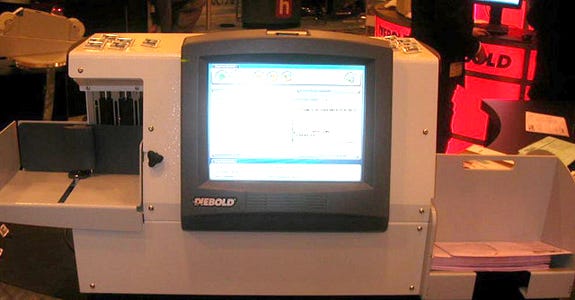
Sequoia (acquired by Dominion Voting Systems in 2010) and Smartmatic
- Sequoia Voting Systems is a California-based vendor.
https://en.wikipedia.org /wiki/Sequoia_Voting_Systems

1a. As of 2010, Sequoia accounted for roughly 20% of US election equipment. https://www.bradblog.com/?p=7906
2. In 2005, Sequoia was acquired by a voting machine firm called “Smartmatic.” The acquisition raised eyebrows in the U.S. because, in 2004, the Hugo Chavez-led Venezuelan government had selected Smartmatic “to provide the voting machines system for the presidential recall election, even though it would have been the company’s first time providing machines for an election.” https://maloney.house.gov/media-center/press-releases/smartmatic-announces-sale-sequoia-voting-systems
http://www.nytimes.com/2006/10/29/washington/29ballot.html

3. “Smartmatic teamed up with a Venezuelan software company, Bitza, which at the time was 28 percent owned by Chavez’s government.” https://maloney.house.gov/media-center/press-releases/smartmatic-announces-sale-sequoia-voting-systems
4. According to the Congressional testimony of a CIA agent, the 2004 election and recount in Venezuela appeared to have been rigged for Chavez. The agent further stated that Chavez controlled all of the voting equipment before the election. Although not mentioned by the CIA agent expressly, this would have included Smartmatic’s voting machines. http://www.mcclatchydc.com/news/politics-government/article24530650.html


5. The concerns over Smartmatic’s acquisition of Sequoia triggered an investigation in the United States. http://www.nytimes.com/2006/10/29/washington/29ballot.html
6. In December 2006, presumably due to the controversy, Smartmatic announced that it had sold Sequoia. https://maloney.house.gov/media-center/press-releases/smartmatic-announces-sale-sequoia-voting-systems
7. But questions remained as to whether the sale was a sham transaction designed to fool regulators. https://www.nist.gov/sites/default/files/documents/itl/vote/SequoiaSmartmaticReport61208.pdf

8. In 2007, the California Secretary of State asked the Computer Security Group at U.C. Santa Barbara to analyze the security of Sequoia’s voting machines. The report found “a number of serious security issues” that “could be exploited by a determined attacker to modify (or invalidate) the results of an election” and that could “be carried out without any knowledge of the source code.” http://votingsystems.cdn.sos.ca.gov/oversight/ttbr/red-sequoia.pdf
9. An analysis of the source code by @mattblaze and others at UC Berkeley found that “the Sequoia system lacks effective safeguards against corrupted or malicious data injected onto removable media, especially for devices entrusted to poll workers and other temporary staff with limited authority…” http://votingsystems.cdn.sos.ca.gov/oversight/ttbr/sequoia-source-public-jul26.pdf
10. The researchers further found that “Many of the security features of the Sequoia system, particularly those that protect the integrity of precinct results, employ cryptography” that is “easily circumvented.” http://votingsystems.cdn.sos.ca.gov/oversight/ttbr/sequoia-source-public-jul26.pdf
11. The researchers concluded that “virtually every important software security mechanism is vulnerable to circumvention.” https://www.wired.com/2007/08/ca-releases-sou/
12. Due to security concerns, California withdrew approval for the use of Sequoia machines (as well as Diebold & HART machines), but then granted re-approval for the use of Sequoia’s machines subject to added precautions. http://www.govtech.com/security/California-Decertifies-Voting-Machines-Conditions-Applied.html

13. Thirteen other states states continued using Sequoia machines as well. https://www.theverge.com/2012/11/6/3609506/voting-machine-electronic-voting-history-in-america
14. One of those states was New York, which in 2008 revealed that it had “found problems with 50 percent of the roughly 1,500 ImageCast optical-scan machines (shown in the video above) that Sequoia Voting Systems has delivered to the state so far…” https://www.wired.com/2008/07/ny-50-percent-o/
15. The year before, Sequoia was identified as the company that had supplied the notorious faulty punch cards during the 2000 election — the very punch cards that led Congress to pass legislation moving the country away from punch cards and toward electronic voting machines. Several former workers told Dan Rather that Sequoia had changed the paper stock before the election and knew in advance the punch cards would cause problems. https://www.wired.com/2007/08/sequoia-voting/
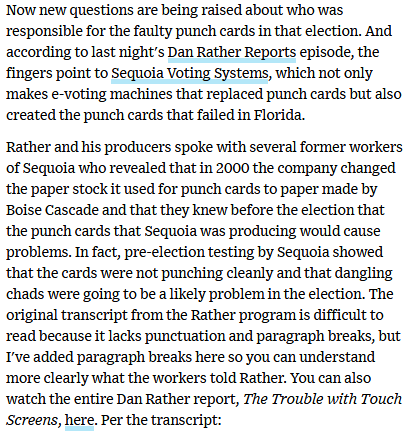
16. In 2010, a Canadian company called “Dominion Voting” bought Sequoia and some of the assets of another major player in the voting machine business, Diebold Election Systems (which was renamed “Premier” in 2007). https://www.sos.ca.gov/elections/voting-systems/vendors/sequoia-voting-systems/
I discuss both Smartmatic and Dominion (a privately held company) in further detail later in this article.
Diebold Election Systems/Premier (previously called “Global Election Systems”)
17. Until 2010, Diebold was the second largest voting machine vendor in the U.S. (The largest was ES&S discussed later in this article.) https://www.wired.com/2009/09/diebold-sells/
18. In 2004, Diebold was estimated to control about 50% of the electronic voting market. http://money.cnn.com/2004/08/30/technology/election_diebold/ …

19. Diebold entered the voting machine business with its 2002 acquisition of Global Election Systems, a company whose Senior VP (programmer Jeffrey Dean) was a CONVICTED FELON who had served time for sophisticated crimes involving “COMPUTER TAMPERING”.
https://www.wired.com/2003/12/con-job-at-diebold-subsidiary/ [“According to a public court document released before GES hired him, Dean served time in a Washington state correctional facility for stealing money and tampering with computer files in a scheme that ‘involved a high degree of sophistication and planning.’”];
https://www.theguardian.com/politics/2005/feb/02/houseofcommons.society [“Stephenson also discovered that Jeffrey Dean, the senior programmer of the Diebold Gems central tabulator system counting a third of the votes in the Bush-Kerry election in 37 states, has a police record. He pleaded guilty to 23 counts of embezzlement involving sophisticated manipulation of computer accounting records.”]
http://www.nytimes.com/2004/01/23/opinion/democracy-at-risk.html …

20. Global brought on Dean shortly before the 2000 election. A few months later, it hired a convicted drug trafficker — who Dean met in prison — to oversee punch card printing. https://people.csail.mit.edu/rivest/voting/press/2004-04%20Vanity%20Fair%20-%20Hack%20The%20Vote.pdf … … …
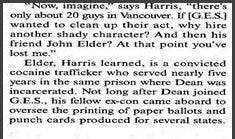
21. As reported in some (or all) of the above stories, Dean’s criminal past and relationship to Global/Diebold were discovered by election integrity advocate and “Black Box Voting” author Beverly Harris.
22. Here is a copy of the SEC filing (obtained by Harris) showing that Dean was Global’s largest shareholder in 2001.
23. Here is an excerpt from Dean’s sentencing document, also obtained by Beverly Harris.
24. Diebold told the AP that Dean left the company in 2002. http://blackboxvoting.org/bbv_chapter-14.pdf … … …

25. But Harris obtained Dean’s court file, which included internal Diebold memos showing that Dean remained as a Diebold consultant.
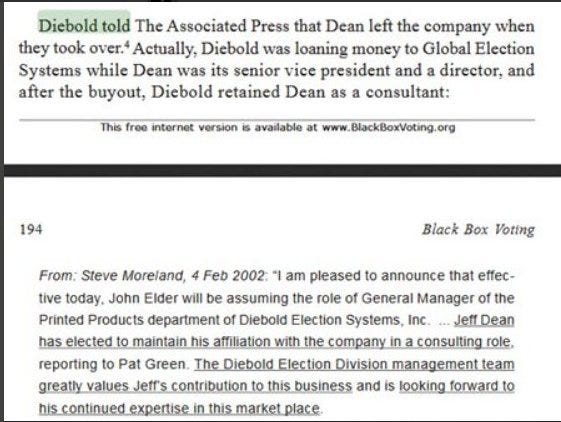
26. According to Wired, Dean “wrote & maintained…code used to count hundreds of thousands of votes.” https://www.wired.com/2003/12/con-job-at-diebold-subsidiary/ … …
27. According to the Guardian, Dean also programmed the GEMS central tabulator system, which counted one third of the votes in 37 states in 2004. https://www.theguardian.com/politics/2005/feb/02/houseofcommons.society … … …

28. In 2004, Diebold was estimated to control about 50% of the electronic voting market. http://money.cnn.com/2004/08/30/technology/election_diebold/ …
29. According to the non-partisan election integrity group @VoterGA, Georgia’s Election Board and Attorney General “were given a copy of the conviction papers for Jeffrey Dean but took no action.”
https://voterga.org/category/uncategorized/ …

30. Because elected officials and news organizations never followed up on Dean’s whereabouts, we can only speculate as to when (if at all) Dean’s relationship with the company ended.
31. In 2010, Dominion bought Diebold’s intellectual property rights and warehoused equipment.
But ES&S kept some — perhaps even most — of Diebold’s servicing and maintenance contracts, which is where control of elections would mostly come from.
Note the name of the Dominion spokesperson in this article; I do not know if there is a relationship. http://news.abs-cbn.com/nation/05/07/10/source-code-firm-dominion-sheds-light-voting-glitch
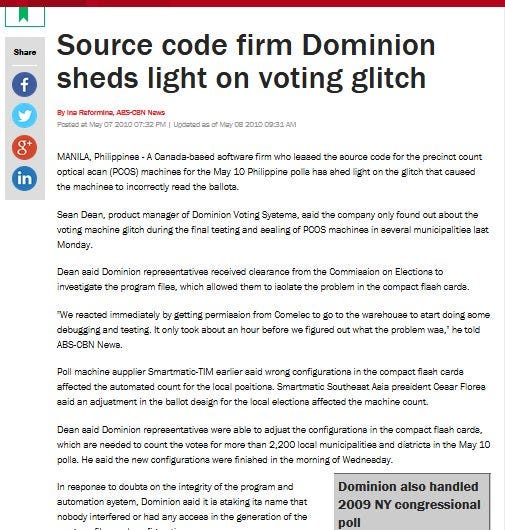
32. Meanwhile, Diebold, Inc.’s CEO (Walden O’Dell) — who made the decision to acquire Global back in 2002 — was a member of Bush’s Rangers & Pioneers, an elite group of loyalists who … raised at least $100,000 each for the 2004 race.” that http://www.nytimes.com/2003/11/09/business/machine-politics-in-the-digital-age.html …

33. According to the New York Times, Diebold’s executives donated exclusively to the Republican party in 2003. http://www.nytimes.com/2003/11/09/business/machine-politics-in-the-digital-age.html …
34. The president of Diebold’s Election Division at that time was Bob Urosevich. Bob Urosevich had previously been president of Global and also had founded another major player in the voting machine market, Election Systems & Software (“ES&S”) of Nebraska. He founded ES&S with his brother, Todd Urosevich, who remained at ES&S as a Senior vice president.

https://www.verifiedvoting.org/resources/voting-equipment/premier-diebold/accuvote-tsx/ … [“Diebold acquired Global Election Systems (GES) in January 2002. GES was renamed Diebold Election Systems (DES), and Robert Urosevich, who had been President of GES, became the CEO of DES.”]
http://www.omaha.com/columnists/kelly/kelly-this-omaha-company-shaped-how-america-counts-its-election/article_459030e0-b522-5a7b-b953-1e6c958e5439.html [Bob Urosevich founded ES&S under the name “DataMark,” received “an infusion of capital from .. California billionaire William Ahmanson,” and changed the company name to “American Information Systems,” which became “ES&S in 1997 after the acquisition of [BRC].” Bob’s brother “Todd is a vice president of ES&S.”]
Election Systems & Software (“ES&S”)
35. ES&S has been a heavy-hitter for many years. In 2010, Wired described ES&S as the “national’s largest voting-machine maker, with machines being used in 43 states. ES&S systems were ‘utilized in counting approximately 50 percent of the votes in the last four major US elections,’ according to the company’s website.” https://www.wired.com/2009/09/diebold-sells/
35a. According to a 2017 analysis, ES&S is America’s largest voting machine vendor, accounting for 44% of US election equipment, with Dominion at 37%. https://trustthevote.org/wp-content/uploads/2017/03/2017-whartonoset_industryreport.pdf (added 11/20/20)
I suspect this analysis underestimated ES&S’s influence (and overstated Dominion’s) because it put all jurisdictions using Diebold equipment into the Dominion column even where ES&S kept the Diebold servicing and maintenance contracts. Verified Voting’s Verifier tool does the same. (See, e.g., Shelby County, Tennessee, which it lists as Dominion, even though it still uses Diebold machines, and ES&S has the servicing and maintenance contract for those machines.)
35b. ES&S has donated $30,000 to the Republican State Legislative Committee since 2013. https://www.nybooks.com/daily/2018/11/05/voting-machines-what-could-possibly-go-wrong/ (added 11/20/20.)
36c. In recent years, ES&S has made headlines for data breaches and other mishaps and for misleading about remote access and internet connectivity to its voting systems. Votes from predominantly African American precincts have also vanished from ES&S systems in Georgia in 2018 and Memphis in 2015. (The systems were supplied initially by Diebold, but ES&S had the servicing & maintenance contracts when the black votes disappeared.)
https://money.cnn.com/2017/08/17/technology/business/chicago-voter-records-exposed-upguard/index.html (ES&S exposed records of 1.8 million Chicago voters online.)
https://www.vice.com/en/article/mb4ezy/top-voting-machine-vendor-admits-it-installed-remote-access-software-on-systems-sold-to-states (ES&S secretly installed remote access software in county tabulation systems)
https://www.nbcnews.com/politics/elections/online-vulnerable-experts-find-nearly-three-dozen-u-s-voting-n1112436 (researchers find ES&S receiving end election systems connected to the internet for months)
https://www.theroot.com/exclusive-thousands-of-black-votes-in-georgia-disappea-1832472558 (vanishing black votes in Georgia)
https://www.nybooks.com/daily/2020/10/31/how-safe-is-the-us-election-from-hacking/ (vanishing black votes in Memphis)
(outside audit blames ES&S for sloppy system integration that left 118,000 names off printed voter rolls in Los Angeles County during the 2018 primary.”)
36. ES&S resulted from the 1997 merger of American Information Systems and Business Records Corporation (“BRC”).
https://en.wikipedia.org/wiki/Election_Systems_%26_Software#Electronic_Poll_Books_for_the_City_of_Chicago [“American Information Systems acquired the Election Services Division of Business Records Corporation and was reincorporated as Election Systems & Software, Inc. in December 1997. .. As a result of this merger, ES&S becamse the largest voting system vendor in the United States.”]
37. BRC was reportedly funded by former billionaire Nelson Bunker Hunt. http://www.yesmagazine.org/issues/whose-water/whose-voting-machines
38. And the family of Howard Ahmanson played a “key role” in financing American Information Systems, ES&S’s predecessor, which acquired BRC.
http://www.omaha.com/columnists/kelly/kelly-this-omaha-company-shaped-how-america-counts-its-election/article_459030e0-b522-5a7b-b953-1e6c958e5439.html?utm_medium=social&utm_source=email&utm_campaign=user-share [“In 1979 [Robert Urosevich] got an infusion of capital from a family friend with Omaha roots, California millionaire William Ahmanson. The company’s name was changed to American Information Systems.”]
http://www.motherjones.com/politics/2005/12/nation-under-god/ … [“[T]wo heavy contributors to the Chalcedon Foundation-Reconstruction’s main think tank-are Howard Ahmanson and Nelson Bunker Hunt, both of whose families played key roles in financing electronic voting machine manufacturer Election Systems & Software.”]
39. Hunt and Ahmanson were early members of the Council for National Policy. http://www.seekgod.ca/cnp.ho.htm#nhunt [Nelson Bunker Hunt — “CNP vice president, 1982–1983; President Executive Committee 1983–1984; CNP Executive Committee 1988, member 1998”]
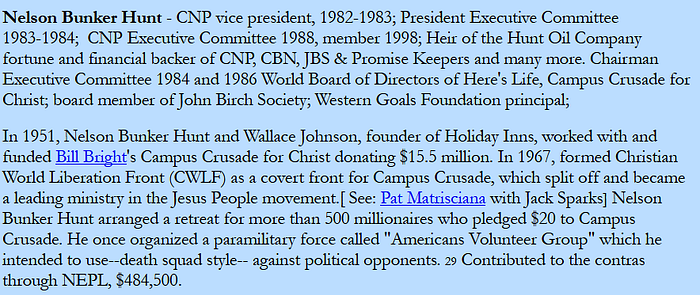
http://www.seekgod.ca/cnp.a.htm#ahmanson [Howard Ahmanson — CNP member 1984–85, 1988, 1996, 1998].
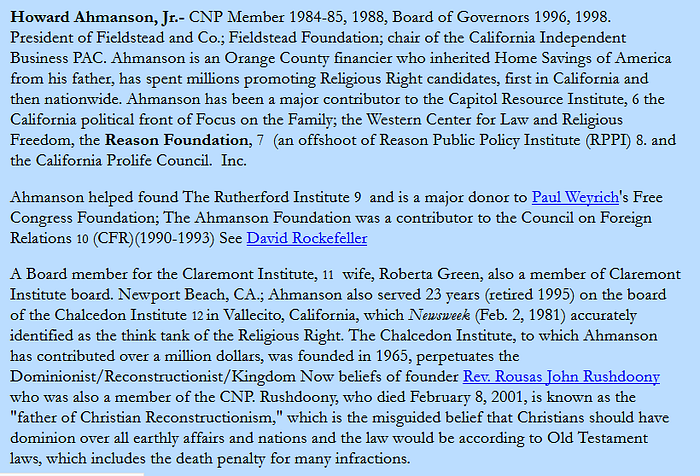
40. “The Council for National Policy (CNP) is an umbrella organization and networking group for social conservative activists in the United States. … Nation magazine has called it a secretive organization that ‘networks wealthy right-wing donors together with top conservative operatives to plan long-term movement strategy.’” http://www.washingtontimes.com/topics/council-for-national-policy/
41. The CNP was founded in 1981 by “at least five fathers,” including “Christian activist Paul Weyrich,” billionaire Nelson Bunker Hunt, the Rev. Tim LaHaye (then head of the Moral Majority), “businessman and one-time murder suspect T. Cullen Davis,” and “wealthy John Bircher William Cies.” http://abcnews.go.com/Politics/story?id=121170&page=1 …
42. Weyrich (now deceased) co-founded several other organizations as well, including:
- The Moral Majority (with the Reverend Jerry Falwell),
- The Heritage Foundation,
- The Free Congress Foundation, and
- ALEC.
http://www.latimes.com/local/obituaries/la-me-weyrich19-2008dec19-story.html [Weyrich founded the Moral Majority, the Heritage Foundation, and the Free Congress Foundation]
https://www.splcenter.org/hatewatch/2016/05/17/council-national-policy-behind-curtain … [CNP founder Weyrich co-founded ALEC]
43. Here is a 1980 video of Paul Weyrich where he says “I don’t want everybody to vote.”https://www.youtube.com/watch?v=8GBAsFwPglw
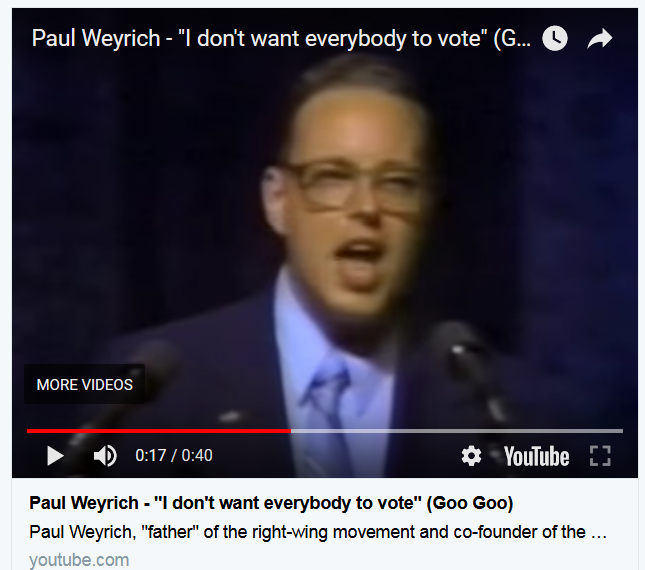
44. In recent years, the CNP has kept its member lists confidential. But the Southern Poverty Law Center obtained and published one from 2014. Here is a link to the directory. https://www.splcenter.org/sites/default/files/cnp_redacted_final.pdf …
45. As shown in the 2014 directory, the CNP’s recent members include Kellyanne Conway, Steve Bannon, Richard DeVos, Jim DeMint, Ken Blackwell (member of Trump’s voter fraud commission), and Wayne LaPierre of the National Rifle Association.
46. Pence said he had joined the CNP, but this may not have been literal. https://medium.com/@archiestrauss/pence-constituents-never-forget-governor-a-continuing-compendium-a2d1cdc94d8b …

47. The New Yorker says the Mercers are also in the CNP.
48. The CNP’s 2014 vision statement lays out its goal: “A united conservative movement to assure, by 2020, policy leadership and governance that restores religious and economic freedom, a strong national defense, and Judeo-Christian values under the Constitution.”
https://www.splcenter.org/hatewatch/2016/05/17/council-national-policy-behind-curtain … …The CNP’s goals for 2020 include.
49. CNP members Hunt & Ahmanson (who are now deceased) were also large contributors to the Chalcedon Foundation, Christian Reconstructionism’s main think tank. http://www.motherjones.com/politics/2005/12/nation-under-god/ … …
50. Here is a link to a document apparently created by Gary North explaining what Christian Reconstructionism is and is not. https://www.garynorth.com/freebooks/docs/pdf/christian_reconstruction.pdf
51. ES&S also has close ties to former Senator Chuck Hagel (R).
52. In 1996, Hagel was chairman of ES&S. That year, Hagel stepped down from his position as chairman and launched his Nebraska Senate bid two weeks later.
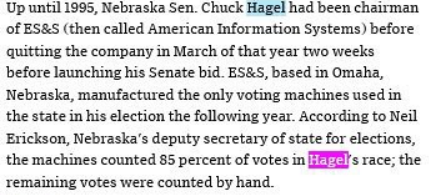
53. A pre-election poll called the race a “dead heat,” but Hagel won by 15 points https://harpers.org/archive/2012/11/how-to-rig-an-election/3/ …
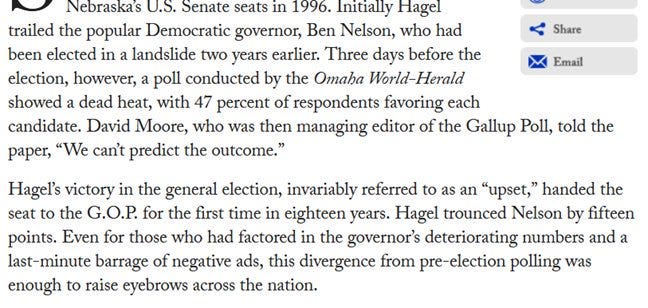
54. Nebraska’s deputy secretary of state for elections, confirmed that ES&S machines counted 85 percent of the votes in Hagel’s race. (The remaining votes were counted by hand.)
https://www.wired.com/2004/03/how-e-voting-threatens-democracy/ …
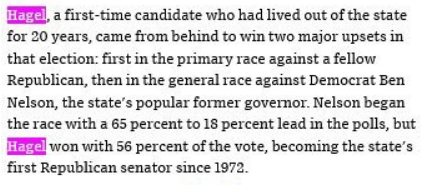
55. With his 1996 Nebraska senate victory, Hagel became the state’s first Republican senator since 1972. (See above for source.)
56. As discovered by election integrity advocate Beverly Harris, although Hagel relinquished his chairmanship with the company, he maintained a substantial ownership interest in McCarthy Group, which owned 25% of ES&S. His treasurer also was chairman of McCarthy Group and sat on ES&S’s board of directors.

56a. The McCarthy Group still controls ES&S. https://federalnewsnetwork.com/government-news/2019/07/whos-behind-voting-machine-makers-money-of-unclear-origins/
56b. The McCarthy Hroup’s chairman and founder, Mike McCarthy, was Hagel’s campaign treasurer. https://harpers.org/archive/2012/11/how-to-rig-an-election/3/
56c. In 2007, the University of Pennsylvania analyzed ES&S touchscreens (DREs) and optical scanners and found “numerous exploitable vulnerabilities in nearly every component of the ES&S voting system” https://www.usenix.org/legacy/event/evt08/tech/full_papers/aviv/aviv.pdf
The analysis further stated that, “a voter or poll worker with a Palm Pilot and no more than a minute’s access to a voting machine could surreptitiously recalibrate the [ES&S iVotronic] touch-screen so that it would prevent voters from voting for specific candidates or cause the machine to secretly record a voter’s vote for a different candidate than the one the voter chose.” This would require “no password, and the attacker’s actions, the researchers say, would be indistinguishable from the normal behavior of a voter in front of a machine or of a poll worker starting up a machine in the morning.”
The U.S. Election Assistance Commission has also found flaws w/ ES&S optical scanners. https://www.computerworld.com/article/2500224/u-s--finds-flaws-in-es-s-ds200-voting-machine.html
(I added this paragraph on 11/20/20.)
57. In 2009, ES&S acquired Diebold/Premier, but the Department of Justice forced ES&S to sell because the combined company accounted for seventy percent of US voting equipment! Diebold/Premier was thus purportedly “dissolved” and its assets split between ES&S and Dominion Voting.

57a. The DOJ forced ES&S to sell Diebold’s warehoused equipment and intellectual property rights. (Although not reported, it seems that ES&S kept most of the Diebold contracts, which is a big deal because the contracts are what gives a vendor control). (added 11/20/20)
57b. ES&S (rather than Dominion) is generally considered Diebold’s successor. https://www.georgiademocrat.org/2019/01/breaking-democratic-party-of-georgia-calls-on-safe-commission-to-delay-vote-following-news-that-voting-machine-lobbyist-is-longtime-kemp-crony/ [“ES&S is the latest iteration of Diebold…”] (added 11/20/20)
Dominion Voting
58. In 2010, Dominion bought not only some of the assets of Diebold/Premier (intellectual property rights and warehoused equipment), but also Sequoia.

https://www.sos.state.co.us/pubs/elections/VotingSystems/files/2015/projectPlans/Dominion.pdf

60. As of 2017, Dominion and ES&S account for roughly 80 percent of US election equipment. https://trustthevote.org/wp-content/uploads/2017/03/2017-whartonoset_industryreport.pdf(Note: This previously provided an estimate of 90 percent. 80% seems more accurate so I changed this to reflect that on 11/20/20)
61. Fortune.com has described Dominion and ES&S as two “monster companies” that dominate the U.S. voting machine market. “But don’t try to estimate the size of the election market based on SEC filings: Dominion is privately held, & ES&S is fully owned by Omaha-based private equity group McCarthy Capital.” http://fortune.com/2014/11/04/who-profits-from-election-day/ …

62. As discussed in computerworld.com, “[E]lection system makers can operate in much the same manner as any vendor to build code; that includes using overseas developers.” Dominion, for example, “develops its systems in the U.S. and Canada but also has an office in Belgrade, Serbia,” and was recently advertising openings for four senior software developers in Belgrade.”
Hart InterCivic
63. Meanwhile, it has been reported that the Romney family has ties to voting machine vendor Hart InterCivic. https://www.forbes.com/sites/anthonykosner/2012/11/06/the-technological-foundations-of-todays-election-are-shaky-especially-in-ohio/#3581da5ff2d5

EasyVote
64. In addition, a company called EasyVote has installed some sort of voting software across 85 Georgia counties and 8 other states.
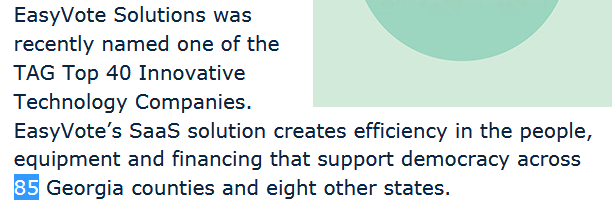
65. I doubt anyone has vetted EasyVote to see what political donations, if any, its officers and directors have made or if the company employs anyone with a criminal record. Although not nearly on the level of a political donation or criminal background, the CTO did retweet the following post, which suggests a partisan bias:
More on Smartmatic
66. Since before the 2016 election, a rumor has circulated that George Soros owns voting machine company Smartmatic (the company that previously owned Sequoia and has ties to Chavez). This isn’t true.
Instead, according to Wikipedia, Smartmatic’s chairman (Malloch Brown) has “been closely associated” with Soros with whom he has worked “to fund humanitarian functions.” Malloch Brown also was named vice-chairman of two important Soros organizations and rented Soros’s apartment while working on United Nations assignments. https://en.wikipedia.org/wiki/Mark_Malloch_Brown,_Baron_Malloch-Brown#Association_with_George_Soros
67. The ongoing concern and confusion over the ownership and associations of Smartmatic and other voting machine companies brings me to my last point, which is this: The current absence of readily available public information about these vendors contributes to the toxic distrust between the parties. Voting machines are the electronic equivalent of counting paper ballots behind closed doors, and no one should have to trust their votes to companies that have not been thoroughly vetted with detailed reports publicly posted by state election officials.
68. It seems this will not happen without a law compelling our elected officials to conduct this basic due diligence. So let’s get a law. It’s time to shine a bright light on the companies that hold the keys to our democracy.
